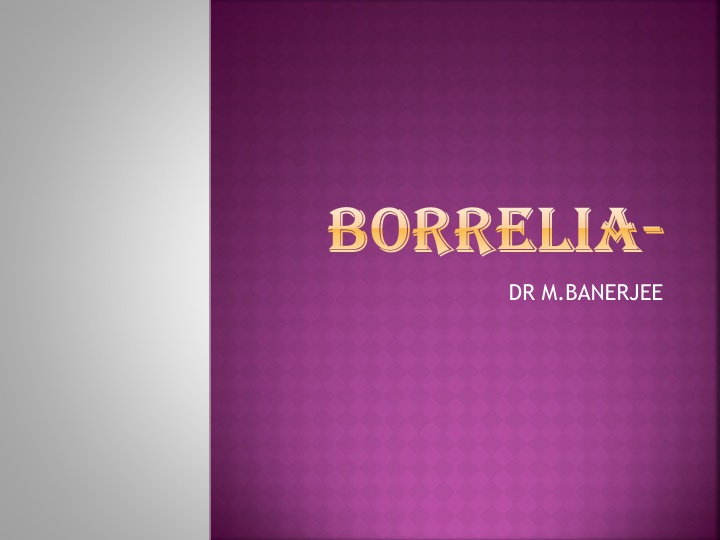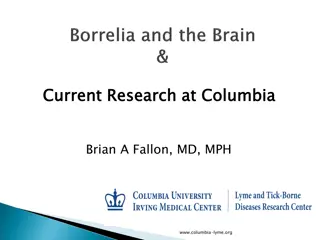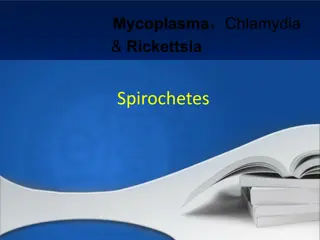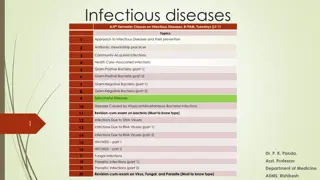
Borrelia Infections and Relapsing Fever: Characteristics and Epidemiology
Learn about Borrelia spp., the causative agents of diseases like Lyme disease and Vincent's Angina, as well as the characteristics and epidemiology of relapsing fever caused by Borrelia recurrentis and tick-borne Borrelia species. Explore the morphology, cultural characteristics, and transmission modes associated with these medically important spirochetes.
Download Presentation

Please find below an Image/Link to download the presentation.
The content on the website is provided AS IS for your information and personal use only. It may not be sold, licensed, or shared on other websites without obtaining consent from the author. If you encounter any issues during the download, it is possible that the publisher has removed the file from their server.
You are allowed to download the files provided on this website for personal or commercial use, subject to the condition that they are used lawfully. All files are the property of their respective owners.
The content on the website is provided AS IS for your information and personal use only. It may not be sold, licensed, or shared on other websites without obtaining consent from the author.
E N D
Presentation Transcript
BORRELIA BORRELIA- - DR M.BANERJEE
INTRODUCTION Borrelia spp are large, motile, refractile spirochetes with irregular wide open coils. Measuring about 0.2-0.3um in diam. & 3- 20um in length. 3-10 loose coils with 15-29 periplasmic flagella. Gram negative & stained well with Giemsa stain.
SOME MEDICALLY IMPORTANT SOME MEDICALLY IMPORTANT BORRELIA BORRELIA- - B. recurrentis Relapsing fever B. burgdorferi- Lyme s disease B. vincenti- Vincent s Angina
RELAPSING FEVER Arthropod born infection 2 types Louse born Tick born
RELAPSING FEVER Characteristic Louseborn Tickborn Epidemology Epidemic Usually endemic Agent B. Recurrentis B. hermesii, B. turicatae, B. parkeri YES Shedding in saliva & discharges No Transovarial transmission NO YES Clinical features MORE SEVERE LESS SEVERE
RELAPSING FEVER B. RECURRENTIS EPIDEMIC RF Exclusive human pathogen . Transitted from person to person through body lice (Pediculus human corporis) No extra human reservoir .
TICK BORN RELAPSING FEVER ENDEMIC RF Normally live in natural host- Rodents or other mammals on which ticks feed. Human infection --- Accidental event - -- Zoonotic disease.
BORRELIA RECURRENTIS- Morphology- Irregular spiral with one or both ends pointed. Possesses 5-10 loose spiral coils at interval of about 2mm Cultural characteristics- Microaerophilic, temp- 28-30 C Cultivation is difficult but can be cultivated on modified Kelly s medium Grows well on CAM (Chorioallantoic. Memb) of chick embryos. Inoculated in mice & rats intraperitoneally.
ANTIGENIC PROPERTIES- Readily undergoes antigenic variation in vivo. Therefore occurrence of relapses in the disease. Antigenic variation is due to DNA rearrangements in linear plasmids. * Recovery after no. of relapses is due to development of immunity to all antigenic variants
CLINICAL FEATURES- Onset is typically abrupt (I.P.- 2-10 days) High fever (40 C ) ( borrelia are demonstrable) Shaking chills, delirium, severe muscle aches, pain in bone & joints Hepatosplenomegaly Louse born may associated jaundice , hemorrhages and high rate of fatality Neurologic complications
CLINICAL FEATURES- Fever subsides in 3-5 days Afebrile period (4-10 days)(disappearence) Relapse(reappearence) 3-10 relapses Disease subsides
EPIDEMOLOGY- Poverty, overcrowding & lack of personal hygiene Epidemic were common during war & in jails Louse infestation is severe than tick In lice borrelia does not get shed in saliva No transovarial tansmission in lice. Indian tick vectors- Ornithodorus tholozoni, crossi, lahorensis.
PATHOGENESIS Inc PD - 2 10 days, Lice born transmitted by rubbing and crushing of lice on abraded skin surface Tick born transmitted by - bites or their discharges * Fever of sudden onset Borrelie are abundant in pt s blood. Fever subsides in 3-5 days. After 4-10 days of afebrile pd (borrelia are not demonstrable in blood) another bouts of fever sets in. Borrelia reappears in blood during ralapses of fever. After 3-10 relapses disease subsides.
LAB DIAGNOSIS- Borrelia can be found in blood during fever Drop of blood- Dark ground OR Phase contrast microscopy Blood smears- Giemsa/Leishman/dilute Carbol fuchsin Inoculation of 1-2 ml blood into white mice I/P & smear is prepared from blood collected from tail of vein after 2 days, observed daily for 2 weeks. Fluoroscent procedures Serology & cultures are unreliable. False positive reaction for syphilis(VDRL)
Prophylaxis- Prevention of louse infestation using insecticides. Identification & avoidance of tick infested places Treatment- Tetracyclines, chloramphenicol, penicillin, erythromycin are effective.
LYMES DISEASE Identified in 1975 in Lyme , Connecticut ,USA. Is a most common vector born disease in USA Causitive agent Borrelia burgdorferi -B.garinii, B.afzeli
EPIDEMOLOGY- Vector- Ixodid tick - transmits by bite Resorvior Rodents dear and other mammals Borrelia grows mainly in midgut of the tick. Infection occurs by regurgitation of the gut content during biting. Most commonly Vector- born infection found in North eastern states in USA. No vertical transmission in ticks. Most effective tick stage of transmission is - nymph
CLINICAL DISEASE- I.P.-3-30 days. Three stages- 1) Localized infection- - Erythema chronicum migrans . -macule at the site of bite with redness, induration. 2) Disseminated infection- -fever, headache, myalgia , arthralgia, lymphadenopathy. -Most common lesions are meningitis & arthritis
3) Persistant infection- -Chronic skin lesions, chronic neurologic symptoms & chronic arthritis , polyneuropathy ,encephalopathy.
LAB DIAGNOSIS- Culture- modified Kelly s medium -Most effective in early Lyme s disease Morphologic detection- silver impregnation method - Insensitive method. Molecular detection- more sensitive method Serologic detection- diagnostic method of choice. -EIA, Immunofluoroscence , Immunoblot tech. Cross reactions- -specific treponemal Ag, HIV, EBV, ricketssial infections.
Treatment- Doxycycline, amoxycilline & cefuroxime
VINCENT ANGINA Caused by borrelia vincenti . Is a mouth commensal but may, under predisposing conditions such as malnutrition, viral infections, give rise to ulcerative gingivostomatitis or oropharyngitis (Vincent angina)
In this B. vincenti is always associated with fusiform bacilli (fusobacterium fusiforme) Symbiotic infection is called as fusospirochetosis .
This symbiotic infection can be demonstrated in some of the lung abscess, phagedenous skin ulcers & gangrenous balanitis.
Morphology- Motile spirochetes, 5-20um 0.2-0.6um wide with 3-8 coils. Easily stained with dilute carbol fuchsin & is Gram negative.
DIAGNOSIS- Demonstration of spirochetes & fusiform bacilli in stained smears Culturing is difficult. Molecular methods- PCR T/t- Penicillins Metronidazole







